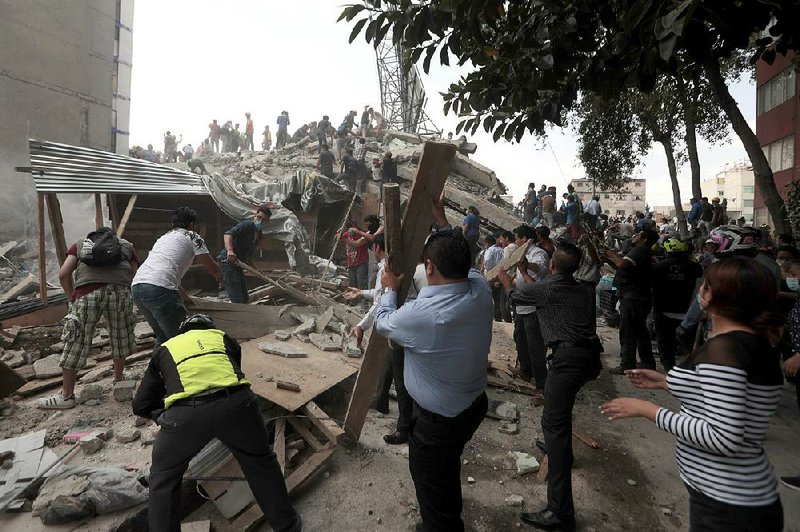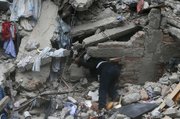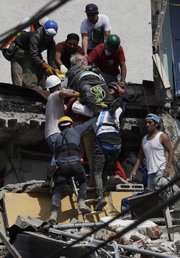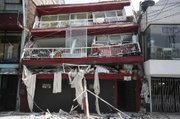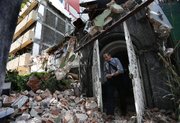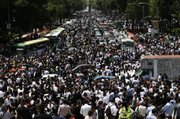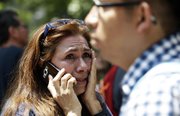MEXICO CITY -- A magnitude-7.1 earthquake stunned central Mexico on Tuesday, killing at least 149 people as buildings collapsed in plumes of dust. Thousands fled into the streets in panic, and many worked to help rescue those who were trapped.
Dozens of buildings tumbled into mounds of rubble or were severely damaged in densely populated parts of Mexico City and nearby states. Mayor Miguel Angel Mancera said buildings fell at 44 places in the capital alone.
Tuesday's earthquake struck on the 32nd anniversary of another major disaster: the 1985 quake that killed as many as 10,000 people in Mexico. It came less than two weeks after another powerful quake left 90 dead in the country's south.
Hours after the quake, rescue workers were still clawing through the wreckage of a primary school that partly collapsed in southern Mexico City, looking for any children who might be trapped. Some relatives said they had received Whatsapp message from two girls inside.
Click here for larger versions
Photos by The Associated Press
Photos by The Associated Press
[RELATED: Mexico visit on despite earthquake; Arkansas governor to see school, talk trade]
President Enrique Pena Nieto visited the school late Tuesday and said 22 bodies had been recovered there, two of them adults. He added in comments broadcast online by Financiero TV that 30 children and eight adults were still reported missing. Rescuers were continuing their search and pausing to listen for voices from the rubble.
Luis Felipe Puente, head of the national Civil Defense agency, reported Tuesday night that the overall confirmed death toll had been raised to 149.
His tweet said 55 people died in Morelos state, just south of Mexico City, while 49 died in the capital and 32 were killed in nearby Puebla state, where the quake was centered. Ten people died in the state of Mexico, which surrounds Mexico City on three sides, and three were killed in Guerrero state, he said.
The count did not include one death that officials in the southern state of Oaxaca reported earlier as quake-related.
The federal government declared a state of disaster in Mexico City, freeing up emergency funds. Pena said he had ordered all hospitals to open their doors to the injured.
The quake caused buildings to sway in Mexico City and sent people throughout the city fleeing from homes and offices. Many people remained in the streets for hours, fearful of returning to the structures.
Mancera said 50-60 trapped people were rescued by civilians and emergency workers in Mexico City.
The federal interior minister, Miguel Angel Osorio Chong, said authorities had reports of people possibly still being trapped in collapsed buildings. He said search efforts were slow because of the fragility of rubble.
"It has to be done very carefully," he said. And "time is against us."
There appeared to be widespread damage, including to a major highway connecting Mexico City to Cuernavaca, the capital of Morelos about 35 miles to the south.
Puebla Gov. Tony Gali tweeted that there were damaged buildings in the city of Cholula, including collapsed church steeples.
In Jojutla, a town in neighboring Morelos state, the town hall, a church and other buildings tumbled down, and 12 people were reported killed.
The U.S. Geological Survey said the magnitude-7.1 quake hit at 1:14 p.m. and was centered near the Puebla state town of Raboso, about 76 miles southeast of Mexico City.
Much of Mexico City is built on a former lake bed, and the soil can amplify the effects of earthquakes centered hundreds of miles away.
The new quake appeared to be unrelated to the magnitude-8.1 temblor that hit Sept. 7 off Mexico's southern coast and also was felt strongly in the capital.
U.S. Geological Survey seismologist Paul Earle noted that the epicenters of the two quakes were 400 miles apart, and most aftershocks are within 60 miles.
Pena said on Twitter that when Tuesday's earthquake hit, he was flying to Oaxaca to inspect the earthquake damage that occurred earlier this month. He immediately returned to Mexico City, he said.
He said the National Emergency Committee would meet to assess the situation and coordinate relief efforts. Earlier Tuesday, Pena attended a memorial service for those killed in the 1985 earthquake.
In a Twitter message Tuesday after receiving news of the quake, President Donald Trump wrote: "God bless the people of Mexico City. We are with you and will be there for you."
Workplaces across Mexico City had held readiness drills earlier in the day on the anniversary of the 1985 quake, a magnitude-8.0 temblor that killed thousands of people and devastated large parts of Mexico City.
In that tragedy, too, ordinary people played a crucial role in rescue efforts that overwhelmed officials.
COLLAPSED BUILDINGS
In the neighborhood of Roma Norte, an entire office building collapsed. Rescue efforts at the offices quickly got underway to save people trapped in the rubble. Several people suffered injuries and were whisked away in ambulances. Others lay on the ground covered in dust. An unknown number remained trapped or crushed inside.
Talia Hernandez, 28, was on the second floor of the building, taking a tattoo class. When the earthquake hit and tore through the structure, she said, she rolled down the stairs as they were collapsing. She managed to escape but broke her foot in the process.
She said others also managed to flee, and afterward even the area around the building was dangerous. The smell of leaking gas permeated the air, as it has across other damaged parts of the city. Emergency personnel at the scene were pushing bystanders away, fearing an explosion.
"I can't believe I'm alive," she said, weeping and in shock. Medics were pulling shards of glass from her foot.
The scene was cordoned off, and the injured were being carted away on gurneys and placed in ambulances. The building itself was unrecognizable -- it had fallen entirely. The rubble, a brown-colored concrete, rose nearly 20 feet high. The neighboring building was partially destroyed in the collapse as well.
The scene grew frantic as dozens of medical workers, police officers and firefighters shouted to see what people needed. They were hastily trying to make a pulley system to free people trapped near the top of the rubble heap. Construction workers from a nearby site raced to the scene and lined up to help, bearing long wooden poles to help lift pieces of the structure.
SEARCHING THE RUBBLE
Buildings also collapsed across the neighborhoods of Condesa, a fashionable district in the city constructed atop soft soil and vulnerable to earthquakes. Thousands of people stood in the streets, filling the popular neighborhoods with a sense of dread.
On Laredo Street, an entire eight-story apartment building had fallen into the roadway, spilling a heap of concrete and rubble into the street. At least 100 people stood atop the pile clearing it by hand, piece by piece, passing boulders and twisted steel pipes along a human chain that radiated from the heap like spokes.
Shouts filled the air, men barking orders at one another. Then came a call for silence -- to listen for the voices of anyone trapped.
Standing on the sidewalk, Salomon Chertorivski, the secretary of economic development for Mexico City, said he believed that 10 people were trapped inside the structure.
Mariana Morales, a 26-year-old nutritionist, was one of many who spontaneously participated in rescue efforts.
She wore a paper face mask, and her hands were dusty from having joined a rescue brigade to clear rubble from a building that fell before her eyes, about 15 minutes after the quake.
A dust-covered Carlos Mendoza, 30, said he and other volunteers had been able to pull two people alive from the ruins of a collapsed apartment building after three hours of effort.
"We saw this and came to help," he said. "It's ugly, very ugly."
At the Clinica Gabriel Mancera in Mexico City, more than a dozen hospital beds had been set up in the patio outside as a triage center. Leticia Gonzalez, a 45-year-old maid in a nearby apartment building, said she tried to race out of the building, but concrete crashed down as she fled. Her right leg was wrapped in a bandage as she grimaced in pain outside the hospital.
"We were all running like crazy," she said. "This was the worst earthquake I've ever seen."
Information for this article was contributed by Mark Stevenson, Christopher Sherman and Peter Orsi of The Associated Press; by Kirk Semple, Paulina Villegas and Elisabeth Malkin of The New York Times; and by Joshua Partlow of The Washington Post.
A Section on 09/20/2017
